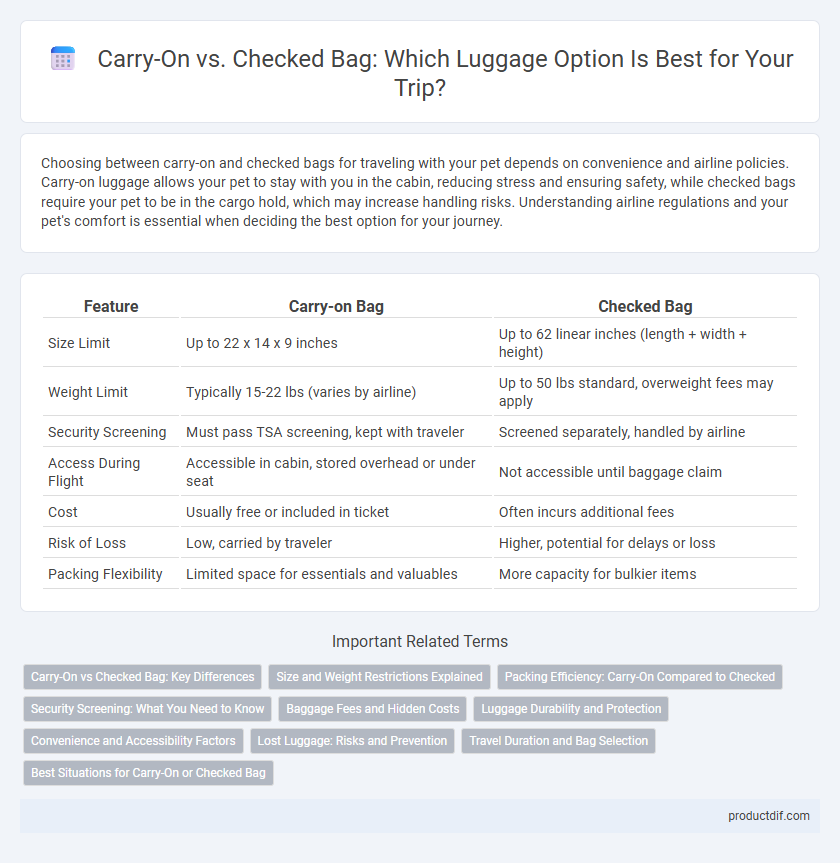Choosing between carry-on and checked bags for traveling with your pet depends on convenience and airline policies. Carry-on luggage allows your pet to stay with you in the cabin, reducing stress and ensuring safety, while checked bags require your pet to be in the cargo hold, which may increase handling risks. Understanding airline regulations and your pet's comfort is essential when deciding the best option for your journey.
Table of Comparison
| Feature | Carry-on Bag | Checked Bag |
|---|---|---|
| Size Limit | Up to 22 x 14 x 9 inches | Up to 62 linear inches (length + width + height) |
| Weight Limit | Typically 15-22 lbs (varies by airline) | Up to 50 lbs standard, overweight fees may apply |
| Security Screening | Must pass TSA screening, kept with traveler | Screened separately, handled by airline |
| Access During Flight | Accessible in cabin, stored overhead or under seat | Not accessible until baggage claim |
| Cost | Usually free or included in ticket | Often incurs additional fees |
| Risk of Loss | Low, carried by traveler | Higher, potential for delays or loss |
| Packing Flexibility | Limited space for essentials and valuables | More capacity for bulkier items |
Carry-On vs Checked Bag: Key Differences
Carry-on bags offer convenience and speed by avoiding baggage claim and reducing wait times at airports, while checked bags allow for larger packing capacity but require check-in and retrieval after flights. Airlines impose specific size and weight limits on carry-ons, typically around 22 x 14 x 9 inches and 15-22 pounds, whereas checked baggage allowances vary widely, often permitting up to 50 pounds per bag. Understanding these differences helps travelers choose the best option based on trip length, airline policies, and packing needs.
Size and Weight Restrictions Explained
Carry-on luggage size restrictions typically allow dimensions up to 22 x 14 x 9 inches and weight limits around 15-22 pounds, varying by airline. Checked bags usually have higher weight limits, often up to 50 pounds, with standard maximum dimensions of 62 linear inches (length + width + height). Exceeding these size and weight limits can result in additional fees or necessitate repacking to comply with airline policies.
Packing Efficiency: Carry-On Compared to Checked
Carry-on bags maximize packing efficiency by encouraging travelers to prioritize essential items within compact dimensions, facilitating quicker access and easier organization. Checked bags offer more space but often lead to overpacking, which can reduce overall efficiency and increase the risk of lost or damaged items. Choosing a carry-on minimizes baggage fees and streamlines airport navigation, enhancing travel convenience.
Security Screening: What You Need to Know
Carry-on bags face stricter security screenings, including removal of laptops and liquids for separate inspection, while checked bags undergo less direct screening but may be subject to X-ray or explosive trace detection. Passengers should ensure all prohibited items are removed from carry-ons before security checkpoints to avoid delays and confiscation. Understanding TSA guidelines for both carry-on and checked baggage helps streamline the screening process and enhances travel efficiency.
Baggage Fees and Hidden Costs
Carry-on bags often avoid baggage fees imposed by airlines, making them a cost-effective choice for travelers aiming to minimize expenses. Checked bags usually incur additional fees that vary by airline and route, sometimes surpassing initial ticket prices due to weight and size surcharges. Hidden costs including overweight penalties, priority boarding charges, and last-minute check-in fees can significantly inflate the total travel budget when checking luggage.
Luggage Durability and Protection
Carry-on luggage generally offers better durability and protection since it remains with the passenger throughout the journey, reducing the risk of rough handling by baggage crews. Checked bags are often subjected to more impacts, drops, and stacking, requiring reinforced materials and sturdy zippers to withstand potential damage. Investing in hard-shell cases with shock-absorbing features significantly enhances luggage protection regardless of its category.
Convenience and Accessibility Factors
Carry-on luggage offers unmatched convenience and accessibility by allowing travelers to keep personal items within reach throughout the journey, avoiding wait times at baggage claim. Checked bags provide more space for packing larger quantities but require early check-in and are subject to potential delays or loss, impacting ease of access. Choosing carry-on luggage typically enhances travel efficiency, especially for short trips or tight connections.
Lost Luggage: Risks and Prevention
Carry-on luggage significantly reduces the risk of lost luggage, as passengers keep their bags in the cabin under their supervision. Checked bags face higher chances of mishandling, misrouting, or delays, with airlines reporting around 3 to 5 lost bags per 1,000 passengers annually. Preventive measures include labeling suitcases clearly, using GPS trackers, and arriving early to allow ample time for proper baggage handling.
Travel Duration and Bag Selection
Travel duration significantly influences the choice between carry-on and checked bags; short trips under three days typically suit carry-ons, offering convenience and faster airport navigation. For extended travels exceeding a week, checked bags provide the necessary space for additional clothing and essentials, reducing the need for packing restrictions. Airlines often enforce size and weight limits differently for carry-on and checked luggage, making it crucial to select the appropriate bag type based on the length of the journey and airline policies.
Best Situations for Carry-On or Checked Bag
Carry-on bags are ideal for short trips, business travel, and when avoiding checked bag fees or delays at baggage claim is a priority. Checked bags are best suited for longer vacations, transporting bulky items or liquids, and when convenience outweighs the risk of lost luggage. Choosing between carry-on and checked luggage depends on trip duration, airline policies, and personal packing needs.
Carry-on vs Checked Bag Infographic

 productdif.com
productdif.com